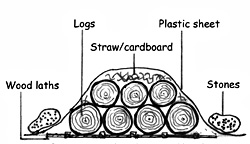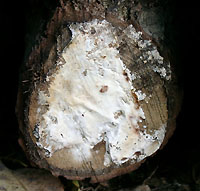Inoculating logs with mushroom plugs
You can grow mushrooms in your garden by inoculating logs with mushroom plugs. You should then be able to harvest the mushrooms for several years. It is quite easy to do this yourself: the inoculated plugs already contain the mushroom mycelia - you only need to drilll holes in the logs and push in the plug. The mycelia then grows from the plugs into the logs. this method is possible for several different types of mushroom. We will now describe how to do this.

Covered log pile for propagating the mycelia (cross section)
You need:
- Fresh logs (see the table of wood types for information on the wood types suitable for each mushroom type)
- Drill with 8 or 9 mmdrill bit, (rubber) hammer
- Inoculated plugs
- For large quantities of wood: Latex milk (for sealing the cut ends)
- Patience ....
Wood quality and the best season for inoculating
Living trees have a built in defence system against fungus growth. The logs must be stored for at least four weeks after felling the tree to ensure that the defence system is no longer active. Try to prevent the logs from drying out during this time. If necessary, you can water them carefully before inoculation.
When you carry out inoculation, it is important that the logs are still moist and that they have not been infested by foreign fungi in the meantime. Accordingly, you should not store them for longer than three months after felling the tree and they should appear healthy.They should not be split or have the bark removed.
In general, you can inoculate logs at any time during the year, but they should be protected from heavy frosts during the propagation phase, above all during the first 6 weeks.
Spring is an ideal time to inoculate, among other things due to availabilty of fresh wood from winter logging activities. If the trees are felled in the winter dormant phase, then the bark sticks better to the logs and the wood sugar content is higher.
In the unopened bag, the plugs will keep for several weeks in the refrigerator but if you use them immediately the mycel is more active. The low temperature is important to slow down the mycelia growth. Warning: The plugs can get soft if you store them for a long time. They are then difficult to insert in the holes in the logs. The mycelia can also grow out of the plugs as a white furc but this is not a problem.
There is also no problem to ship the plugs in the post without cooling.

Inoculated plugs
Plug quantity, inoculation
Thicker logs of about 30 to 40 cm in length and 18 - 20 cm in diameter need 12 to 15 plugs. Thinner logs for shiitake (diameter 10 to max. 15 cm) need 12 to 15 plugs per meter of log. If you use more plugs, this shortens the time needed for the mycelia propagation phase.
Drill with a sharp drill - the wood shouldn't get too hot when drilling because this can led a varnish-like film on the wood which is difficult for the mycelia to penetrate! Spread the holes over the entire length of the log and drill deep enough for the length of the plugs. Bang the plugs into the holes using a hammer. the plugs should not be a loose fit, so the holes should not be too large. Since the mycelia is inside the plugs and not only on the surface, it does not matter if the mycelia on the surface comes off.
It helps to seal the ends of the logs with latex milk, you can even do this directly after felling the trees. This avoids loss of moisture in the wood. However, latex milk is often only available in 5-liter canisters, so this treatment is only really practical if you are inoculating a large number of logs. You should not use tree wax!
Storage after inoculation (so-called propagation phase)
After inoculation you must cover up the logs and store them, either in the garden or in in a storage room (cellar, garage or similar).
Storage in the garden: Make a log pile as follows: Lay down a few sticks or wooden fruit boxes on the ground or grass (not on stone or concrete). Choose a shadowy place in the garden which is not too dry. Then lay the logs on the sticks and cover them up with straw or cardboard or similar and then cover the pile with a dark plastic sheet (see figure). Then punch a few holes in the plastic sheet for air circulation (about 5 holes per m² of area). During the propagation phase, make sure that the mycelia is protected against frost, above all during the first six weeks. Note: All mushroom logs are not affected by Frost after the mycelia has propagated throughout the wood.
Storage indoors: If you want to inoculate in autumn or during the winter, you can store the logs during the propagation phase in a room which is protected against frost. To make sure they do not dry out, you should wrap them up in a plastic sheets or plastic sack! Straw is not necessary in this case. It's best to put the logs back in the garden when the frost period is finished (in a log pile as described above).
The log should now remain in the log pile for several months (about 5-6 months, up to 12 months for shiitake). The storage temperatures should normally not exceed 30°C, otherwise the mycelia could be damaged (do not store the logs in the greenhouse in mid-summer). if you store the logs in the garden, you should check the moisture level from time to time. If you see cracks in the cut ends of the logs, you should water them with a watering can and cover them up again after the outside of the bark has dried again. If the logs are too wet, air circulation can help to prevent mould from growing on the bark. If you store the logs indoors, you should arrange for air to circulate under the plastic sheet from time to time and open the door to let the air circulate in the room for a while.

Shiitake mycelia
After the storing the logs for many months, you should see mycelia on the cut end of the logs as a white furry mould. In the case of shiitake, the colour can be chocolate brown instead. The propagation phase is then finished. A crusts can also form on the mycelia soon after this. The crust tends to be darker for shiitake and a lighter colour for oyster mushrooms. It is now time to put the logs in the garden at their final location.
Putting the logs in the garden
Except for the shii-take logs which remain long and are not buried, the other mushroom logs can now be cut into shorter pieces if necessary. Stump-like logs with a minimum length of 30 – 40 cm are easier to bury in the ground. Bury the logs at a shadowy place in the garden where it is not too windy about 1/2 to 2/3 of their length in nutrient-rich soil which you can mix with compost if necessary. Logs inoculated with changeable agaric mushrooms are best buried up to half on their sides, logs for all other mushroom types are buried vertically. Shii-take logs are not buried at all (see below). it's a good idea to scatter bark mulch all shredded material around the logs. When the mushrooms grow this keeps them clean from earth or sand. In addition, you must protect the logs against slugs, e.g. with a Schneckenzaun. Unfortunately, slugs like all mushroom types.
Fruiting bodies (mushrooms)
After burying in the ground, the logs still need a while until the first mushrooms appear. All logs should be kept moist by rainwater or a watering can. The first mushrooms normally appear around 6 to 18 months after inoculation. This depends on mushroom type, wood type and wood diameter. For example, oyster mushrooms grow quite quickly on popular logs. it can take up to around 24 months for shii-take mushrooms to appear (e.g. growing on large diameter oak logs).
The first mushrooms mushrooms often appear close to the inoculated plugs. In some cases you may only see 1-2 mushrooms at first. The mushroom mycelia grows in the log for several years. Be patient at the beginning, you may have to wait quite is time for the first harvest, but after this the log may bring regular harvests for 4-5 years or more (depending on thickness). The log is only fully consumed when it is completely rotten and disintegrates.
Peculiarities of shii-take logs
Shii-take do not need any contact to the earth, the mycelia does not grow into the ground in this case. After the propagation phase (i.e.aftre about 12 months) the logs are stored vertically, e.g. against a fence or tree or wall.
In the case of shii-take, you can accelerate growth of the fruiting bodies (mushrooms) after the propagation phase by completely immersing the logs for about 24 in cold water (bath tub or rainwater but; weight the logs down if necessary). Mushroom growth is initiated by the cold shock. After this, vigorously bang each of the logs 3 to 4 times with the cut end on a stone slab (without breaking the log), this also accelerates mushroom growth. The first mushrooms should start to appear about 14 days after immersion and cans soon be harvested.
The logs then need a recuperation phase of about 6-8 Wochen, after which you can read Pete immersion in water. The logs may also grow new mushrooms without any further action on your part, above all during rainy weather.
Shii-take mushrooms are harvested when the skin on the bottom of the Has torn open and the lammella are visible but the edges of the cup are still slightly rolled under. the fruiting bodies should then be removed from the log by breaking all cutting, removing as much of the stem as possible.
Download instructions as a pdf file
|